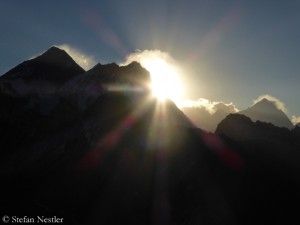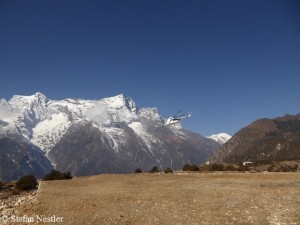Search Results for Tag: Helicopter
Alexander Gukov rescued from Latok I
Good news from the Karakoram: Alexander Gukov is saved. The 42-year-old Russian climber had been trapped for almost a week on the North Ridge of the seven-thousander Latok I at 6,200 meters, without food or equipment. With finally good visibility, but strong wind, Pakistani helicopter pilots managed to get Alexander off the mountain on a long line. Two helicopters were in action.
![]() read more
read more
Climber dies in avalanche in Pakistan
An Austrian climber was killed in an avalanche accident on the 7,338-meter-high Ultar Sar in the Karakoram. Christian Huber died on Friday when the snow masses hit the tent he and his team-mates Bruce Normand and Timothy Miller had pitched on a ridge at an altitude of 5,800 meters. The two uninjured British and the body of Huber were taken from the mountain this Sunday by a rescue helicopter of the Pakistani army. An army spokesman said it was a “daring mission”. The first emergency call had been received on Saturday morning. Bad weather had prevented the helicopter from taking off earlier.
![]() read more
read more
Lämmle after Makalu and Lhotse: “Tactics worked”
Having scaled the fifth and fourth highest mountain on earth, without bottled oxygen and a High-Altitude Sherpa by his side – the spring season in Nepal went like clockwork for the German climber Thomas Lämmle. The 52-year-old from the town of Waldburg in Baden-Württemberg summited the 8,485-meter-high Makalu on 13 May. Only eight days later, on 21 May, Thomas stood on top of the 8,516-meter-high Lhotse, in the immediate vicinity of Mount Everest. Lämmle has now scaled seven eight-thousanders after Cho Oyu (in 2003), Gasherbrum II (in 2005 and 2013), Manaslu (in 2008), Shishapangma (in 2013) and Mount Everest (in 2016). I asked him about his experiences.
Thomas, last year your four summit attempts on Makalu failed due to bad weather. How have you been during your successful summit bid this spring?
![]() read more
read more
Nanga Parbat: Revol’s anger after the rescue
“We could have saved Tomek.” With this sentence, the French mountaineer Elisabeth Revol has triggered a debate. Could her Polish rope partner Tomek Mackiewicz still be alive, whom, suffering from severe high altitude sickness and slowblindness after their summit success on Nanga Parbat, she had had to leave at 7,200 meters, if the rescue at the end of January had started faster? On the late evening of 25 January, Revol had made several emergency calls. “It’s a race against the clock when you set off a rescue,” Elisabeth said at a press conference in Chamonix on Wednesday. “It took, in fact, 48 hours for something to happen. So clearly I have a lot of anger inside of me – and Tomek could have been saved if it had been a real rescue carried out in time and organized.”
![]() read more
read more
Rescue operation on Everest
Alex Txikon has to re-plan. On Sunday his climbing partner on Mount Everest, Carlos Rubio, had to be evacuated by rescue helicopter to Kathmandu due to a lung inflammation. The 28-year-old Spaniard has meanwhile sent a video message from the hospital. His condition is not serious, but he has to recover for a few days at the clinic. “I know he is fine”, Alex Txikon wrote from Camp 3 at 7,400 meters, “but from here we miss him a lot, since he has worked like a champion and I am really proud of him.” Today Txikon and the Sherpas who accompany him want to pitch up Camp 4 at the South Col at almost 8,000 meters, “for all the force he has transmitted to us”, as Alex writes: “In short, this dream would not be possible without you, Carlos.”
![]() read more
read more
Normal, and that’s good
Bad news is good news, learns every prospective journalist. But actually it also can be good news, if there is no bad one. This spring, this applies particularly to Mount Everest, after the disasters of the past two years. In spring 2014, the season on the Nepalese side ended prematurely, after an ice avalanche in the Khumbu Icefall had killed 16 Nepali climbers. 2015 even turned out to be a year without summit success on both sides of the mountain due to the devastating earthquake in Nepal. On the south side, 19 people lost their lives, when the quake triggered an avalanche that hit the Base Camp. Later all climbers departed. On the north side, the Chinese authorities closed all eight-thousanders after the earthquake in the neighboring country. This year, in my view, the Everest season is running so far largely normal.
![]() read more
read more
Helicopter transport flights to Everest high camps
Time does not stand still, even in Khumbu. Two things have changed dramatically in the region around Mount Everest between my first visit in 2002 and my second last March. Firstly, the sanitary facilities – on average – have become much more modern and cleaner than 14 years ago. Secondly, the aircraft noise has increased significantly. On a clear day, helicopters are flying – as I felt, steadily – through the valley from Lukla to Namche Bazaar and also further up towards Everest Base Camp.
![]() read more
read more
Money for relief flights in Nepal runs short
The World Food Programme (WFP) has sounded the alarm. If the “United Nations Humanitarian Air Service” (UNHAS) does not receive additional money, the helicopter relief flights for the earthquake victims in Nepal have to be stopped at the end of August. According to the WFP, which manages the UNHAS, there is a shortfall of more than nine million US dollars to continue the flights as scheduled until the end of October.
![]() read more
read more
Rescue on Everest completed
All climbers from the high camps on Mount Everest are safe. In the morning the last 17 climbers, who had been stranded at Camp 1 at 6,100 meters, nine Sherpas and eight foreigners, were flown down to the valley by helicopter. An official of the Nepalese Tourism Ministry said, more than 200 climbers had been rescued on Everest. It was the most extensive rescue operation in the history of high altitude mountaineering. According to department reports, at least 19 climbers, including five foreign nationals, have been confirmed dead in two avalanches. It seems that this figure also includes three Sherpas who reportedly died in the Khumbu Icefall during an aftershock on Sunday.
![]() read more
read more
Barely no chance to escape
The quite inconceivable really happened. A huge avalanche from Pumori, triggered by yesterday’s earthquake in Nepal, hit the Base Camp at the foot of Mount Everest at full force. The seven-thousander is located just opposite the highest mountain in the world. But hardly anyone had expected that an avalanche from Pumori would reach the edge of the Khumbu Icefall. “I ran and it just flattened me. I tried to get up and it flattened me again. I couldn’t breathe, I thought I was dead,” said George Foulsham, a mountaineer who lives in Singapore. The 38-year-old marine biologist was lucky and survived. It is not yet totally clear how many climbers lost their lives in Base Camp.
![]() read more
read more
Bad Everest joke
As if nothing had happened. The Chinese climber Wang Jing has received her Everest certificate from the hands of Nepalese government officials in Kathmandu. Thus it is certified that the 41-year-old has scaled the highest mountain in the world on 23 May – officially and above all with no ifs and buts. Strange.
![]() read more
read more
New Everest category “aviation-assisted climb”?
The spring season on Mount Everest is over, but not the discussion about what happened at the highest mountain in the world. The Civil Aviation Authority of Nepal (CAAN) has set up a committee to clarify whether, when and how often helicopters were used to airlift team members of the Chinese female climber Wang Jing and the Brazilian-American Cleo Weidlich to Camp 2 at 6400 meters. On 23 May, Wang was the first person who reached the summit of Mount Everest this spring, just before the first successes from the north side were reported. Weidlich originally planned to climb Lhotse, but in her own words she made no real attempt to reach the summit.
![]() read more
read more

















Feedback